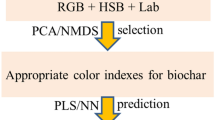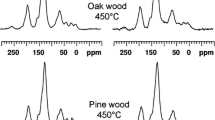Abstract
In order to quickly adjust the production process of biochar, keep the consistency of production conditions and reduce the production cost of biochar. In this paper, maize straw and rice husk were used as raw material for biochar preparation under 350–600 o C fully pyrolyzed by fixed bed quartz tube pyrolysis device. The image recognition technology was used to acquire the RGB value of biochar and translated into gray value. The relationship between gray value and pyrolysis temperature, proximate analysis, and calorific value was studied; the result showed that the gray value had a strong linear relationship with carbonization temperature. Moreover, the relationships between gray scale and volatile, fixed carbon met the DoseResp mold; the R2 reached nearly 0.999. However, the correlations between gray value and ash and net calorific value were weak. This study provided theoretical support for the rapid detection of biochar and timely feedback of large-scale production conditions of biochar.




Similar content being viewed by others
Abbreviations
- RGB:
-
Red–green–blue
- RHB:
-
Rice husk biochar
- CNB:
-
Maize straw biochar
- G:
-
Gray scale
- G1 :
-
The color value of the green part
- H:
-
Net calorific value
References
Shi YC (2011) China’s resources of biomass feedstock [J]. Eng Sci 13(2):16–23
Sun PQ, Sun SH, Chang C et al (2014) The prospects for modern application of biomass energy in China [J]. Sino-Global Energy 13(2):16–23
Chin K, Fan K, Yon C (2015) Pyrolysis and biochar potential using crop residues and agricultural wastes in China [J]. Ecol 51:139–145
Pandey V, Patel A, Patra DD (2016) Biochar ameliorates crop productivity, soil fertility, essential oil yield and aroma profiling in basil (Ocimumbasilicum, L.) [J]. Ecol Eng 90:361–366
Ye D, Yang JY, Ma MX et al (2017) (2017) Research status of biomass pyrolysis technology [J]. Energy and Energy conservation 12:70–72
Li B, Fan CH, Zhang H et al (2015) Combined effects of nitrogen fertilization and biochar on the net global warming potential, greenhouse gas intensity and net ecosystem economic budget in intensive vegetable agriculture in southeastern China [J]. Atmos Environ 100:10–19
Xiang AH, Qi RY, Wang MF et al (2020) Study on the infiltration mechanism of molten urea and biochar for a novel fertilizer preparation [J]. Ind Crops Prod 153
Zheng QF, Wang YH, Sun YG et al (2014) Study on the preparation of biochar structural from different materials and carbonization methods by the FTIR [J]. Spectrosc Spect Anal 4:962–966
Bruun EW, Hauggaard-Nielsen H, Ibrahim N et al (2010) Influence of fast pyrolysis temperature on biochar labile fraction and shortterm carbon loss in a loamy soil[J]. Bio Energ 35(3):1182–1189
Lee JW, Kidder M, Ewans BR et al (2010) Characterization of biochars produced from cornstovers for soil amendment [J]. Environ Sci Technol 44(20):7970–7974
Jin L, Wei D, Li YM et al (2015) Study on the preparation and stability estimation of biochar: a review [J]. J Agric Resour Environ 5:423–428
Wan YQ, Wang YK, Liu YH et al (2010) Study on the microwave pyrolysis technology of biomass: a review [J]. Agric Mechanization Res 3:8–14
Wang MF, Wu YJ, Jiang EC et al (2017) Study on adsorption characteristics of cassava stem from continuous pyrolysis [J]. J Solar Energy 38(08):2047–2054
Xiao L, Zhang ZH, He YM et al (2008) Development and application status of biomass pyrolysis technology in global: A review [J]. An Hui Agric Sci 36:16102–16104
Lin DC, Guo XJ (2016) Analysis the pyrolysis technology of biomass [J]. Renewable Resour Circular Economy 7:30–33
Wang MF, Jiang EC, Li BS et al (2012) Study on continuous pyrolysis of rice husk [J]. Acta Energiae Solaris Sinica 33(1):168–172
Hu W, Hu JH, Wang H et al (2012) Selection of biomass materials producing char and analysis of caloric requirement [J]. Coal Conversion 35(3):80–83
Parikh J, Channiwala SA, Ghosal GK (2005) A correlation for calculating HHVfrom proximate analysis of solid fuels [J]. Fuel 84:487–494
Klasson KT (2017) Biochar characterization and a method for estimating biochar quality from proximate analysis results [J]. Biomass & Bioenergy 96:50–58
Yang F, Liu ZX, Niu WJ et al (2017) Rapid detection of calorific value in straw biochar based on FT-MIR [J]. J Huazhong Agricultural University 36(6):121–126
Cheng X., Niu ZY, Yan HG, et al (2013) Building of calorific value model of straw biomass based on proximate analysis indexes [J]. Transactions of the Chinese Society of Agricultural Engineering Transactions of the CSAE) 29(11):196-202.
Cordero T, Marquez F, Rodriguez-Mirasol J et al (2011) Predicting heating values of lignocellulosics and carbonaceous materials from proximate analysis [J]. Fuel 80(11):1567–1571
Diao Z, Zheng A, Wu Y (2011) Shape feature extraction of wheat leaf disease based on invariant moment theory [J]. Advances in Information & Communication Technology 369:168–173
Omrani E, Khoshnevisan B, Shamshirband S et al (2014) Potential of radial basis function-based support vector regression for apple disease detection [J]. Measurement 55(9):512–519
Dumont J, Hirvonen T, Heikkinen V, et al (2015) Thermal and hyperspectral imaging for Norway spruce (Piceaabies) seeds screening [J]. Computers& Electronics in Agriculture 116(C):118-124.
Jiang D, Li G, Tan C et al (2021) Semantic segmentation for multiscale target based on object recognition using the improved Faster-RCNN model [J]. Future Gener Comput Syst 123:94–104
Jiang D, Li G, Sun Y et al (2021) Manipulator grabbing position detection with information fusion of color image and depth image using deep learning [J]. J Ambient Intell Humaniz Comput. https://doi.org/10.1007/s12652-020-02843-w
Wang MF, Chen XC, Jiang EC et al (2015) Biochar absorption characteristics based on RGB analysis of scanned images [J]. Transactions of the Chinese Society for Agricultural Machinery (Transactions of the CSAM) 46(12):212–217
Lei T, Zhou J, Xu C, et al (2013) Soil biochar quantification via hyperspectral unmixing [C] digital image computing: techniques and applications (DICTA), 2013 International Conference on. IEEE :1–8.
Sadaka S, Sharara MA, Ashworth A et al (2014) Characterization of biochar from switch grass carbonization [J]. Energies 7(2):548–567
Zhang MJ, Li X, Wang YJ (2015) Underwater color image segmentation based on weight adjustment for color-to-gray [J]. J Harbin Eng Uni 36(5):707–713
Xue JJ, Han LJ, Yang ZL et al (2016) On-line measurement of nutrient content of corn stover using NIRS[J]. Transactions of the Chinese Society of Agricultural Machinery (Transactions of the CSAM) 47(7):216–223
Yang XM, Wang YJ, Qiu L et al (2017) Effect of temperature on physicochemical properties of biochar prepared by pyrolysis of three components of biomass [J]. Transactions of the Chinese Society of Agricultural Machinery (Transactions of the CSAM) 48(4):284–290
Matin SS, Chelgani SC (2016) Estimation of coal gross calorific value based on various analyses by random forest [J]. Fuel 177:274–278
Liu J, Yang F, Niu WJ et al (2018) Prediction of Calorific Value of Straw Biochar Based on Industrial Analysis Index [J]. China Agricultural Science and Technology Guide 20(08):142–148
Jahirul MI, Rasul MG, Chowdhury AA et al (2012) Biofuels production through biomass pyrolysis - a technological review [J]. Energies 5(12):4952–5001
Funding
This paper was financially supported by the National Natural Science Foundation of China (51706074) and the Bureau of Guangdong Forestry (Project No.2020KJCX008).
Author information
Authors and Affiliations
Corresponding author
Ethics declarations
Conflict of interest
The authors declare no competing interests.
Additional information
Publisher's note
Springer Nature remains neutral with regard to jurisdictional claims in published maps and institutional affiliations.
Highlights
1. Gray value had a strong linear relationship with carbonization temperature.
2. The relationships between gray scale and volatile, fixed carbon met the DoseResp mold.
3. The relationships between gray scale and ash and net calorific value were weak.
4. Gray value can be a good feedback the problems in the production process of biochar
Wang Mingfeng and Xiang Aihua are contributed equally to this work and should be considered as joint first authors
Rights and permissions
About this article
Cite this article
Mingfeng, W., Aihua, X., Luhan, Y. et al. Study on the quality detection method of biochar based on red–green–blue image recognition technology. Biomass Conv. Bioref. 13, 11533–11541 (2023). https://doi.org/10.1007/s13399-021-01957-1
Received:
Revised:
Accepted:
Published:
Issue Date:
DOI: https://doi.org/10.1007/s13399-021-01957-1




